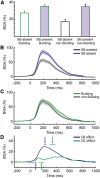Temporal components in the parahippocampal place area revealed by human intracerebral recordings
- PMID: 23761907
- PMCID: PMC6618403
- DOI: 10.1523/JNEUROSCI.4646-12.2013
Temporal components in the parahippocampal place area revealed by human intracerebral recordings
Abstract
Many high-level visual regions exhibit complex patterns of stimulus selectivity that make their responses difficult to explain in terms of a single cognitive mechanism. For example, the parahippocampal place area (PPA) responds maximally to environmental scenes during fMRI studies but also responds strongly to nonscene landmark objects, such as buildings, which have a quite different geometric structure. We hypothesized that PPA responses to scenes and buildings might be driven by different underlying mechanisms with different temporal profiles. To test this, we examined broadband γ (50-150 Hz) responses from human intracerebral electroencephalography recordings, a measure that is closely related to population spiking activity. We found that the PPA distinguished scene from nonscene stimuli in ∼80 ms, suggesting the operation of a bottom-up process that encodes scene-specific visual or geometric features. In contrast, the differential PPA response to buildings versus nonbuildings occurred later (∼170 ms) and may reflect a delayed processing of spatial or semantic features definable for both scenes and objects, perhaps incorporating signals from other cortical regions. Although the response preferences of high-level visual regions are usually interpreted in terms of the operation of a single cognitive mechanism, these results suggest that a more complex picture emerges when the dynamics of recognition are considered.
Figures





Similar articles
-
How reliable are visual context effects in the parahippocampal place area?Cereb Cortex. 2010 Feb;20(2):294-303. doi: 10.1093/cercor/bhp099. Epub 2009 May 20. Cereb Cortex. 2010. PMID: 19457939 Free PMC article.
-
Seeing scenes: topographic visual hallucinations evoked by direct electrical stimulation of the parahippocampal place area.J Neurosci. 2014 Apr 16;34(16):5399-405. doi: 10.1523/JNEUROSCI.5202-13.2014. J Neurosci. 2014. PMID: 24741031 Free PMC article.
-
Full scenes produce more activation than close-up scenes and scene-diagnostic objects in parahippocampal and retrosplenial cortex: an fMRI study.Brain Cogn. 2008 Feb;66(1):40-9. doi: 10.1016/j.bandc.2007.05.001. Epub 2007 Jul 2. Brain Cogn. 2008. PMID: 17606317
-
Timing of posterior parahippocampal gyrus activity reveals multiple scene processing stages.Hum Brain Mapp. 2013 Jun;34(6):1357-70. doi: 10.1002/hbm.21515. Epub 2012 Jan 30. Hum Brain Mapp. 2013. PMID: 22287281 Free PMC article.
-
Impact of Visual Corticostriatal Loop Disruption on Neural Processing within the Parahippocampal Place Area.J Neurosci. 2016 Oct 5;36(40):10456-10471. doi: 10.1523/JNEUROSCI.0741-16.2016. J Neurosci. 2016. PMID: 27707978 Free PMC article.
Cited by
-
Category-Selectivity in Human Visual Cortex Follows Cortical Topology: A Grouped icEEG Study.PLoS One. 2016 Jun 7;11(6):e0157109. doi: 10.1371/journal.pone.0157109. eCollection 2016. PLoS One. 2016. PMID: 27272936 Free PMC article.
-
The medial occipital longitudinal tract supports early stage encoding of visuospatial information.Commun Biol. 2022 Apr 5;5(1):318. doi: 10.1038/s42003-022-03265-4. Commun Biol. 2022. PMID: 35383284 Free PMC article.
-
Identifying task-relevant spectral signatures of perceptual categorization in the human cortex.Sci Rep. 2020 May 12;10(1):7870. doi: 10.1038/s41598-020-64243-6. Sci Rep. 2020. PMID: 32398733 Free PMC article.
-
Defining the most probable location of the parahippocampal place area using cortex-based alignment and cross-validation.Neuroimage. 2018 Apr 15;170:373-384. doi: 10.1016/j.neuroimage.2017.04.040. Epub 2017 Apr 18. Neuroimage. 2018. PMID: 28435097 Free PMC article.
-
Intracerebral Electrophysiological Recordings to Understand the Neural Basis of Human Face Recognition.Brain Sci. 2023 Feb 18;13(2):354. doi: 10.3390/brainsci13020354. Brain Sci. 2023. PMID: 36831897 Free PMC article. Review.
References
Publication types
MeSH terms
LinkOut - more resources
Full Text Sources
Other Literature Sources
